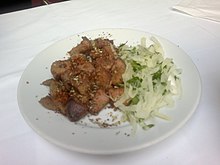Arnavut ciğeri
Arnavut ciğeri ( tr. For " Albanian liver") is a Turkish dish made of lamb or veal cubes fried in oil, seasoned with hot paprika, which is traditionally served with onions and parsley. The word Arnavut (Albanian) is the namesake of various dishes in Istanbul cuisine, although the Arnavut ciğeri itself is completely unknown in today's state of Albania . The Albanian liver is often part of the meze as part of a sofra .
The Arnavut ciğeri was created in the 15th century in the course of the Balkan Wars of the Ottomans in Rumelia . People traveling from the Balkans to Ottoman Anatolia exerted influence on this region: Albanians often served as traveling sellers of raw liver. In the late 17th century, the traveler Evliya Çelebi noticed the Albanians because they worked disproportionately often as butchers in Istanbul. They came from the Tuscan regions around Ohrid , Korça and Hurupişte (now Argos Orestiko in Greece ) and sold lamb products such as liver, heart and kidney. The court Arnavut ciğeri was to Ottoman times a part of Turkish cuisine; the Ottomans quickly assimilated the culinary traditions, cooking practices and customs of the people they encountered - including the Armenians , the Greeks , the Circassians , the Kurds , the Arabs and, of course, the Albanians, as the example of Arnavut ciğeri shows.
Individual evidence
- ↑ a b c d 1453: İstanbul kältür ve sanat dergisi . İstanbul Büyükşehir Belediyesi Kültür A.Ş. Yayınları, 2012, 14-15, pp. 32 ( here in the google book search - Ve bitmez tükenmez Balkan savaşları. İnsan Rumeli Türkülerindeki hüznün bu savaşlarda Ölenlerden yansıdığını sanıyor ... İlk anda Anadolu'dan Rumeli'orokye daha çok gidiliçi Çaha. Balkan ... Arnavut sözcüğü İstanbul mutfağının yemeklerinden birinin de adıdır. Arnavut ciğeri Arnavutların Seyyar çiğ Cíger satıcısı oldugunu biliyoruz as Evliya Çelebi, Seyahatnamesi'nde şu tespiti yapar. "Bu ciğercilerin hepsi Ohri, Görice, Horpuşta Arnavutlarıdır Nice'm taze ciğeri. kırkar ellişer tanesini, yüreği, böbreği, şirdeni bumbarıyla sırıklara dizip 'İyi koyun ciğeri' diye feryat ederler. ").
- ^ Mehrdad Kia: Daily Life in the Ottoman Empire . ABC-CLIO, 2011, ISBN 978-0-313-06402-9 , pp. 225 ( here in the Google book search - As with their political and administrative practices, the Ottomans managed to assimilate the best of the culinary traditions they encountered and merge them with their own cooking customs and practices in such a way as to bring about the enrichment of their own cuisine. In this fashion, Albanian liver (Arnavut cigeri), Circassian chicken (Çerkes tavugu), Kurdish meatballs (Kürt köftesi), and Arab meatballs (Arap köftesi), were assimilated into the Ottoman Turkish cuisine, while kebabs, pilafs , böreks, dolmas (stuffed grape leaves), yogurt meals, biscuits, meals with olive oil, and syrupy desserts were introduced by the Turks to the countries they conquered.).
